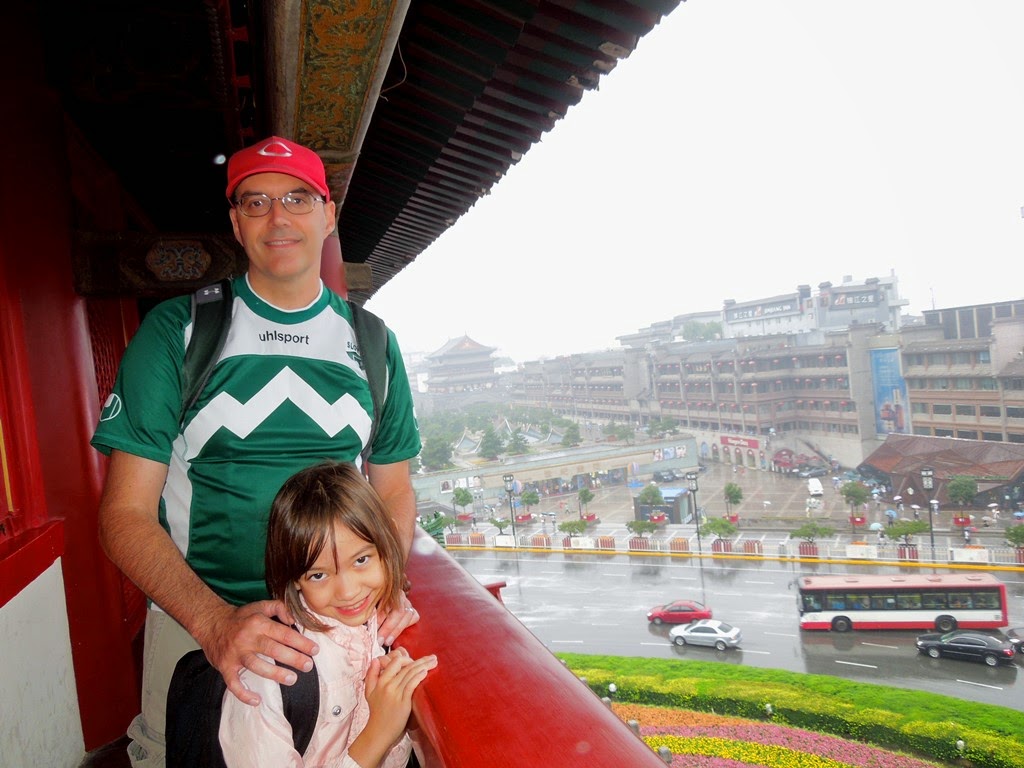The Bell Tower 钟楼
Xī'ān 西安 - a city once known as Cháng'ān 长安, back in the days when it was the terminus of the fabled Silk Road and one of the Four Great Ancient Capitals of China. Nowadays, Xi'an is a provincial capital home to 6.5 million people, and is like many Chinese cities - congested, dirty, noisy, polluted and just plain ugly in many parts. But within its still-standing ancient city walls are several sites that evoke a China of days gone by, while beyond the city limits lie the Army of the Terracotta Warriors and other relics of the imperial past. For anyone spending time in China, or just traveling through, Xi'an is a worthwhile stop, one that we found time for during this just completed (U.S.) Labor Day holiday weekend.
We flew into Xi'an late on Friday evening and took a taxi to our hotel, the Sofitel. On Saturday morning, we awoke to the rain that would last throughout the day, putting a damper on our sightseeing to some extent, but at the same time cleansing the air of Xi'an's notorious (even by Chinese standards) smog. First stop on our itinerary was the Bell Tower (pictured above). Originally built in the 14th century (and rebuilt in the 18th), it was once home to a large bell that was rung at dawn each day. Even in the rain, the views from the tower were impressive:
Looking down Bĕi Dàjiē 北大街
Our next destination - the Drum Tower 鼓楼
The South Gate, part of the 14-kilometer (8.7 miles) perimeter of the old city walls surrounding Xi'an
Father and daughter take in the view
The Drum Tower was just a short walk away. Finished around the same time as the Bell Tower, it was used to house the drum that marked each nightfall. We arrived just in time to see another performance:
Once the drumming display was over, we checked out the inside and outside:
Different kinds of drums were on display (当然!)
The rain was really coming down at this point
Looking down on the Muslim Quarter, home to the predominantly Muslim ethnic group known as the Hui خُوِذُو / حواري.
Mother and daughter take in the view
From the Drum Tower, we descended into the Muslim Quarter. The covered alley was full of stalls selling tourist crap, but at least we weren't being rained on. On the other hand, our feet still got soaked wading through some deep puddles. The effort was worth it, however, as came to the Great Mosque 清真大寺, one of the largest in China. It was an oasis of calm and contemplation from the chaos just outside its walls.
The first mosque I've ever visited looked very Chinese in its design and layout...
...but the Arab influence could be seen in places
The giant Prayer Hall was not open to visitors (read non-Muslims)
demonstrating once again the inclusiveness that is the hallmark of the
major Western religions, but it was still an impressive structure. Plus
it was possible to get a peak of the interior.
Leaving the house of worship behind, it was time to descend back into the Muslim Quarter and sample some the eats the Hui like to dine on...
Lunch consisted of noodles, kebabs and naan bread, washed down with an Ice Peak orange soda (very halal, I'm sure). It all tasted good, but my infidel intestines were to pay a heavy price later that afternoon.
Pamela bought some tasty nut cakes for dessert
Beiyuanmen, the street that runs through the Muslim Quarter, is lined with Muslim restaurants and the usual souvenir shops.
Back at the traffic circle surrounding the Bell Tower, we flagged down a taxi to go to our next destination, the Big Goose Pagoda 大雁塔. Xi'an's traffic is a nightmare of clogged streets, honking horns and insane drivers...like our cabbie.
The pagoda sits within the precincts of Dàcíēn Sì temple, Xi'an's largest, first established in 647. The pagoda was built at the behest of Xuánzàng 玄奘, a 7th-century Buddhist monk who traveled to India and returned to China carrying a treasure trove of Buddhist texts. The brick pagoda was erected as a fireproof storehouse for these sutras. The seven-story-high tower stands over 60 meters (nearly 200 feet) tall.
The views from the top floor were worth the hike up
The area around the temple has been developed into a large tourist shopping mall, with souvenir stores, cafes and restaurants all catering to the non-spiritual needs of the tour bus visitors. A big draw is the large fountain behind the temple, where a nightly musical show pulls in the visitors.
Dacien Si and the Big Goose Pagoda were the end of our sightseeing activities. We had trouble finding a taxi willing to take us back to our hotel, but a private vehicle soon pulled up to the curb and offered to take us anywhere in the city for 30 RMB ($4.90). Despite the fact that as part of our outreach program I've been warning American visitors to Shánghăi 上海 of the risks of taking such "black taxis", my wife immediately said yes and hopped in. In any event, we found ourselves back at our hotel, where we relaxed for the rest of the evening after having dinner in preparation for the next day's journey to see the Terracotta Warriors.


































No comments:
Post a Comment